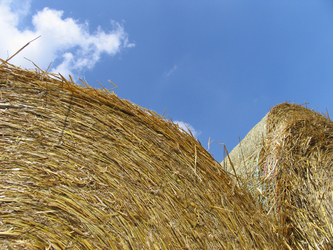Making Hay
Posted: 7/13/2015
By: Rebecca Christman

We’ve had a beautiful summer so far, but this time it seems like the heat is back to stay. Although it can make doing chores on the farm miserable, it means it’s the perfect time for making hay!
Like most things on the farm, the work comes in seasons. During the hottest months of the year, we are putting up hay. The grass is cut, dried, and made into big round bales that will keep our cows bellies full during the coldest months of the year.
Putting up hay means that we are spending a lot of hours in the tractor. But to make sure the hay is a good quality feed and won’t spoil, it has to be put up at exactly the right time. That means when the time is right, you spend as much time in the tractor as you can making bales. We all know the weather can change in an instant here in South Dakota.
It would seem that hay is hay, right? It gets cut, dried, put into rows, and baled. How much more could there be? However this year, we are putting up three different types of hay. Oat, alfalfa, and grass hay are getting ready to be put in bales and stored for the winter. Each type of hay has a different nutritional value and will be used in a different way.
Oat hay – Oats are high in protein and energy. Baling the stalk and the seeds
makes a nutrient dense hay.
Grass hay – This type of hay doesn’t provide as much nutritional value, however
it is useful as a filler in the ration and keeps the cattle full.
Alfalfa hay – The leaves in the alfalfa provide vitamins and minerals that are an
important part of the cattle diet.
Although we’re all suffering through the heat this week, I know that it’s a blessing in disguise. Because of the heat, we’re making hay!
Listen to this week's radio segment here! FARMERS_DAUGHTER-JULY_13TH.mp3

Comments
blog comments powered by Disqus